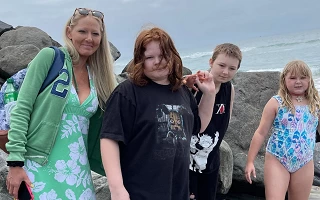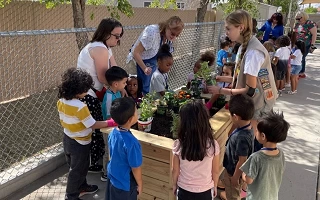The mantra of children heard around the country during summer break – or any break – or even weekends for that matter. In an effort to “fix” boredom, parents often turn to structured activities, groups, clubs, sports, and anything else designed to fill up a child’s time. In fact, in today’s world, it is often considered good parenting to leave no minute of a child’s day unstructured.
The mantra of children heard around the country during summer break – or any break – or even weekends for that matter. In an effort to “fix” boredom, parents often turn to structured activities, groups, clubs, sports, and anything else designed to fill up a child’s time. In fact, in today’s world, it is often considered good parenting to leave no minute of a child’s day unstructured.

- Create- Markers, crayons, pencils, paint, and paper are great. But how can we kick the creativity up a notch? What if we’re outside with only water guns? What if we’re outside with paper but no drawing or writing utensils? What if we don’t even have paper or drawing utensils? Hmm….
- Discover- What have you noticed your child being curious about? A well-placed question can go very far in leading a child to a journey of discovery. Not only that, but expressing curiosity and wonder is a great example to foster continuing curiosity and love of learning. Most parents would be gratified to find out that knowing all the answers is not what leads a child to learning. What does the trick is seeing a parent not know the answers, but eager to engage the process of learning. Parental curiosity is truly a powerful example for children to watch. In all this, the most important thing is letting the child discover the answers him/herself using their own planning and methods. Perhaps a lot of trial and error is involved, but that is also an important and necessary part of the process.
- “Hmm. I wonder why these rocks are all different colors.”
- “Oh dear. I keep forgetting what time the sun sets. That would be very helpful to know for my gardening.”
- “Oh…sorry. I know you wanted a lot of colors, but we only have red, yellow, and blue. I wonder if there’s any way to get more colors out of this.”
- “I wish I knew how long the porch is. I don’t have a ruler long enough to measure.”
- “I have a list of places I want to go to, but I need to figure out the best route. I wonder if this map is helpful.”
- Solve/Fix it- For the older child, learning to sew on a button or fix a hem can be a very useful skill to know. For a younger child, mending damaged books can bring them back to readable status again. Tinkering with, taking apart, and exploring old broken electronics might not make them work again, but can provide great experiences in curiosity.
- Cook it- What would kids put together if given the chance to create their own dessert? How would they change a recipe to make it “their own”? What would happen if they were simply told to make something out of what’s in the pantry and refrigerator?
- Just be- Create an opportunity for a child to sit and be present in the moment. This can be difficult even for many adults, so a few questions to ponder and get the process started can be very helpful.
- “See how the tree moves in the wind? I’m trying to figure out what it reminds me of.”
- “I wonder how many different shades of blue there are in the sky.”
- “This sunset is beautiful. I’ve lost count of all the colors in it.”
- “I wonder if all clouds are shaped like something.”
- “I think it’s amazing that the stars we see today are the same stars that the cavemen saw. I wonder what they used to think of them.”
The key is to stop seeing boredom as a problem and start seeing it as an opportunity. A great start is learning to appreciate it ourselves. We can also consider some of the great feats of creativity and inspiration that have come from boredom.
Contact our Parents as Teachers program for more information about inspiring creativity and imagination, as well as offering support in many areas of parenting, early learning, and child development by connecting you with a certified Parent Educator who will work with you and your child in the comfort of your home.









